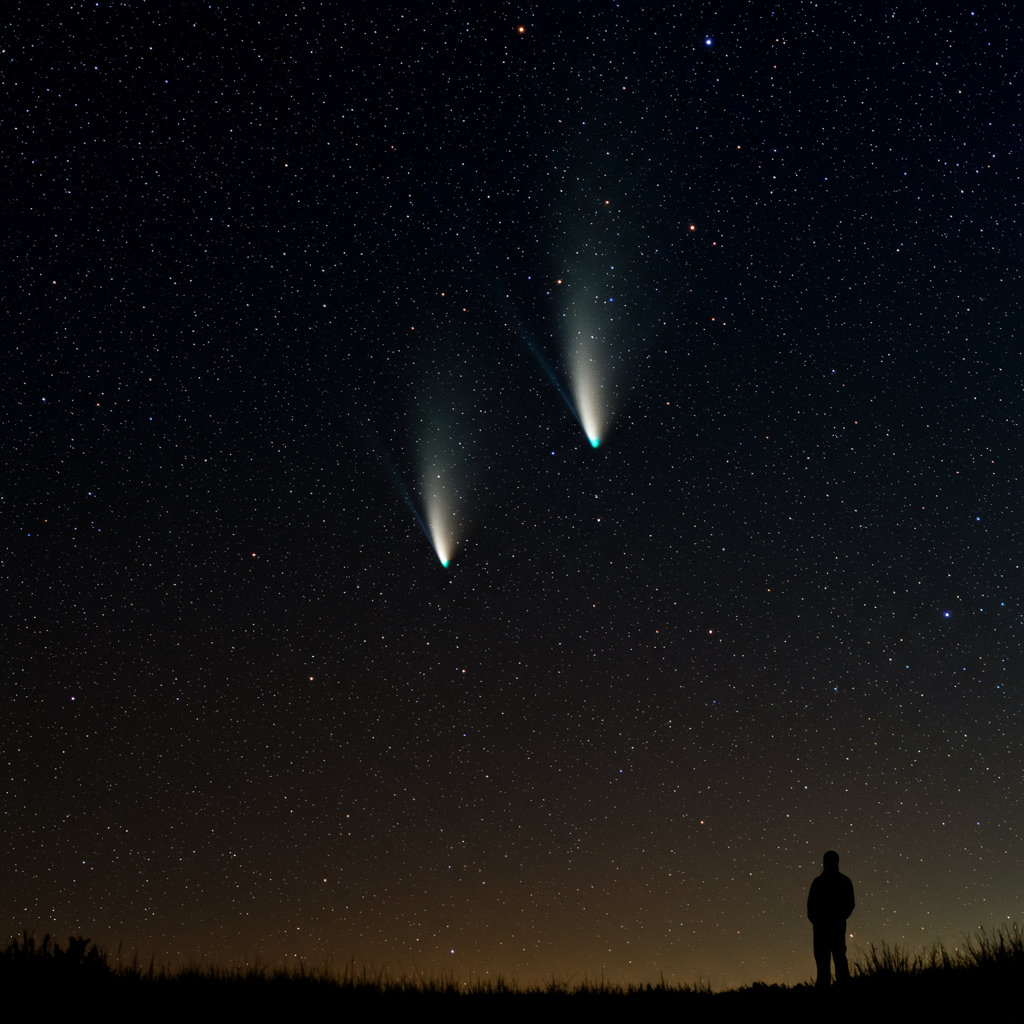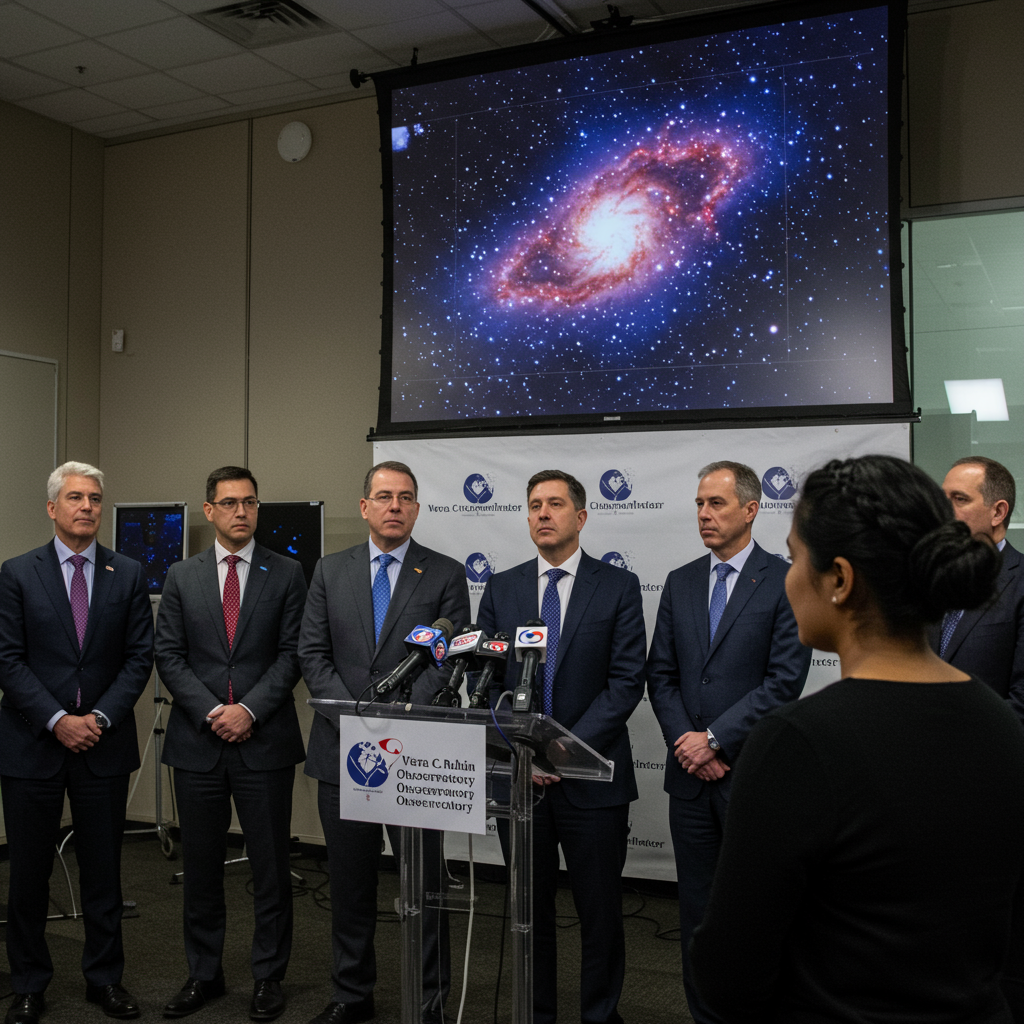This week, prepare for a truly extraordinary celestial event: the simultaneous close approach of two rare, green-glowing comets, C/2025 A6 (Lemmon) and C/2025 R2 (SWAN). These recently discovered “dirty snowballs” offer a unique, once-in-a-lifetime viewing opportunity for dedicated stargazers and casual observers alike. Don’t miss this chance to witness these emerald visitors light up our night sky, alongside the annual Orionid meteor shower. Our ultimate guide reveals exactly how and when to find them.
A Rare Cosmic Rendezvous: Comets Lemmon and SWAN Arrive
The night sky is offering an exceptional treat with the simultaneous visibility of two remarkable comets. Comets Lemmon and SWAN, both fresh discoveries, are making their closest passes to Earth this week. Unlike the familiar Halley’s Comet, which returns every 75 years, these celestial wanderers have incredibly long orbital periods. This means that for current observers, this week marks your singular opportunity to see them. Their distinctive green glow adds to the spectacle, making them truly unforgettable.
Astronomers are buzzing with excitement over this “rare cosmic treat.” It has been a year without any comets easily visible to the unaided eye. Now, two are arriving concurrently, each on its own vast journey through space. These comets are remnants from our solar system’s formation, offering a glimpse into the distant past.
The Science Behind the Green Glow
Both Comet Lemmon and Comet SWAN are noted for their stunning emerald hue. This vibrant green glow emanates from diatomic carbon (C2) molecules in their comas. The coma is the fuzzy cloud of gas and dust surrounding the comet’s nucleus. As these icy bodies approach the sun, its radiation breaks down C2 molecules, causing them to emit this specific green light. This natural phenomenon creates a beautiful, otherworldly spectacle.
Comets are often described as “dirty snowballs.” They originate from the cold, outer reaches of our solar system, like the Kuiper Belt and the more distant Oort Cloud. These icy relics preserve dust and ice virtually unchanged for billions of years. Scientists consider them “treasure troves” of the original building blocks of our solar system. Each comet imaged up close looks different, highlighting their dynamic and varied compositions.
Comet Lemmon: The Bright Emerald of the West
Comet C/2025 A6, affectionately known as Comet Lemmon, is anticipated to be the brightest comet visible from Earth this year. It was first spotted on January 3, 2025, by astronomers at the Mount Lemmon Observatory in Arizona, hence its name. This comet is an exciting find, making its first appearance for over a thousand years.
Lemmon made its closest approach to Earth on October 21. It passed approximately 56 million miles (90 million kilometers) from our planet. This icy visitor is steadily brightening as it travels through the inner solar system. Its peak luminosity is expected around October 31 or November 1, potentially making it more distinctly visible to the unaided eye under ideal conditions. Its perihelion, or closest approach to the sun, is set for November 8.
How to Spot Comet Lemmon
For observers in the Northern Hemisphere, Comet Lemmon is best viewed in the western evening sky. Look approximately an hour and a half after sunset. It will be positioned low on the horizon, gradually climbing higher each night as it moves northward. The comet is expected to remain visible from mid-October through early November.
To help locate it, find the Big Dipper constellation. The comet will appear below it along the horizon, in the west-northwest sky. You can also follow the arc of the Big Dipper’s handle stars to “arc to Arcturus.” Comet Lemmon will be about two-thirds of the way along this path. While technically at the threshold of naked-eye visibility (magnitude 4.5), using binoculars is strongly recommended for an optimal view. Moonlight might interfere with observations, so choose dark skies.
Comet SWAN: The Fleeting Visitor from the Southwest
Comet C/2025 R2, known as Comet SWAN, is another recent discovery adding to this week’s celestial show. Vladimir Bezugly, an amateur astronomer from Ukraine, spotted it on September 10. The SWAN (Solar Wind Anisotropies) instrument on the SOHO (Solar and Heliospheric Observatory) spacecraft confirmed its existence just a day later, on September 11. It made its closest approach to the sun (perihelion) shortly after, on September 12.
Comet SWAN made an even closer pass to Earth than Lemmon. On October 21, it soared roughly 24 million miles (39 million kilometers) from our planet. This distance is approximately a quarter of the Earth-Sun distance. Despite this close approach, SWAN is intrinsically fainter than Lemmon, with a magnitude of 5.9. This makes it about three times dimmer than its emerald counterpart.
Finding Comet SWAN
Comet SWAN is best observed in the hours immediately following sunset. Look towards the south-southwest horizon. Since it is currently on its journey out of the solar system, it will progressively dim. Binoculars are essential for viewing this icy visitor.
To locate Comet SWAN, search for the constellation Sagittarius. The comet will be passing above it, shifting slightly eastward each night. Alternatively, look near the Summer Triangle, an asterism formed by the bright stars Vega, Deneb, and Altair. The comet will be positioned roughly halfway between Altair and the horizon. Comet SWAN is expected to remain visible through the weekend. However, given its dimming trajectory, catching it sooner rather than later is advisable.
Essential Stargazing Tips for Optimal Viewing
To truly appreciate these rare comets, preparation is key. Here are some actionable tips to enhance your viewing experience:
Find Dark Skies: Get away from city lights. Light pollution significantly hinders visibility, especially for fainter objects. Allow your eyes at least 20-30 minutes to adjust to the darkness.
Use Binoculars: While Comet Lemmon might be just visible to the naked eye under perfect conditions, binoculars are highly recommended for both comets. A good pair, like 10×50 magnification, will reveal their comas and possibly tails.
Consider a Telescope: For an even more detailed view, a small telescope will provide clearer images of the comets’ features.
Stargazing Apps & Charts: Utilize popular night-sky applications such as SkySafari 7, Star Walk 2, Stellarium, Sky Guide, or Sky Tonight. These apps use your phone’s GPS to show you exactly where to look. Online resources like The Sky Live and In-The-Sky.org also provide helpful finder charts.
Check Sunset Times: Consult reliable sources like Timeanddate.com to determine your local sunset times. This helps pinpoint the ideal viewing window, typically an hour and a half after sunset.
Dress Warmly: Even on clear nights, temperatures can drop. Bring layers and perhaps a hot drink to stay comfortable during your observation session.
Join a Livestream: If weather conditions or light pollution make direct observation difficult, consider joining an online event. Astronomer Gianluca Masi and his Virtual Telescope Project hosted a special livestream on October 24. These virtual events offer incredible views and expert commentary, often accessible via Space.com or the Virtual Telescope Project’s YouTube channel.
Dark Sky Havens: Ohio Examples
For those in specific regions, finding a certified dark sky location can make all the difference. In Ohio, for instance, several spots offer excellent viewing conditions:
Geauga Observatory Park: Designated a dark sky spot in 2011, this park hosts the Nassau Observatory.
Fry Family Park: This Magnolia park boasts an IDSP-certified urban dark sky area distinction. It offers good sky views even close to urban areas.
Other Prime Locations: Burr Oak State Park, Stonelick State Park, and the Lamping Homestead Recreation Area within Wayne National Forest are also renowned for their minimal light pollution.
The Orionid Meteor Shower: An Added Spectacle
As if two rare comets weren’t enough, the night sky also features the annual Orionid meteor shower. This shower peaked between October 22 and October 24, with favorable viewing conditions enhanced by a new moon. The Orionids will remain active until around November 7.
These meteors are remnants spawned by the famed Halley’s Comet. Halley’s Comet itself is next due to return in 2061. During its peak, observers could expect to see 10 to 20 meteors per hour. To best enjoy this shower, find a dark location away from light pollution. Simply look up and let your eyes adjust. Recent sightings include a fireball captured over the White Mountains, demonstrating the shower’s potential for spectacular moments.
Why These Comets Matter: A Glimpse into the Universe’s History
The simultaneous appearance of Comets Lemmon and SWAN is more than just a beautiful sight. It offers scientists an invaluable opportunity to study pristine material from the early solar system. These comets are essentially time capsules, preserving the dust and ice that formed our planetary neighborhood billions of years ago. By observing their composition and dynamic changes, researchers gain insights into the universe’s origins.
The distinctive green glow, the unexpected brightening, and the unique orbital paths of these “dirty snowballs” provide crucial data. Every comet behaves differently as it interacts with the sun’s radiation. Occasionally, “disruption events” occur, where chunks are flung off, creating ripples in their tails. Such events are rare and dynamic sights in space. The ultimate scientific holy grail for comets is a sample return mission. This would allow direct study of ancient ice and dust, offering an unparalleled connection to the history of the universe.
Frequently Asked Questions
Why do these comets glow green, and what makes them so rare?
Both Comets Lemmon and SWAN exhibit a distinct green glow due to diatomic carbon (C2) molecules in their comas. As sunlight energizes these molecules, they emit green light, creating the stunning visual effect. Their rarity stems from their exceptionally long orbital periods. Comet Lemmon has an orbital period of approximately 1,179 to 1,350 years, while Comet SWAN’s orbit is estimated at around 1,400 to 22,000 years. For most people, this week’s close approach is a once-in-a-lifetime opportunity to observe them.
What equipment and tools are best for spotting Comets Lemmon and SWAN?
While Comet Lemmon might be barely visible to the naked eye under very dark conditions, binoculars are highly recommended for both comets. A pair of 10×50 binoculars, for example, will significantly enhance your view. A small telescope will provide even greater detail. To locate them, use stargazing apps like SkySafari 7, Star Walk 2, Stellarium, or Sky Tonight, which offer real-time sky maps based on your location. Online finder charts from resources like The Sky Live can also be very helpful. For those unable to observe directly, look for official livestreams, such as those hosted by the Virtual Telescope Project.
When is the absolute best time to view Comets Lemmon and SWAN this week?
Comet Lemmon reached its closest point to Earth on October 21 and is expected to reach peak brightness around October 31 or November 1. It’s best viewed an hour and a half after sunset in the west-northwest sky, visible through early November. Comet SWAN made its closest approach to Earth on October 21 as well, but it is already dimming as it moves away from the sun. The best time to spot SWAN was also an hour and a half after sunset, in the south-southwest sky, though it may remain visible through the weekend. Always check local sunset times to plan your viewing window.
Don’t Miss This Cosmic Masterpiece
The vast and wondrous sky is showcasing a truly spectacular display this week. The rare, green-glowing Comets Lemmon and SWAN, coupled with the annual Orionid meteor shower, offer an unparalleled opportunity for stargazers. This is a chance to connect with the ancient origins of our solar system and witness celestial beauty that won’t return for millennia. Gather your binoculars, find a dark spot, and look up. These icy travelers are waiting to be discovered, providing a continuous show for all to enjoy.




